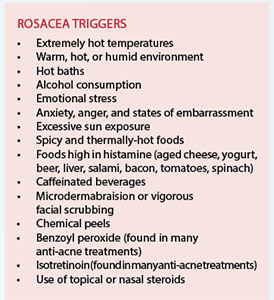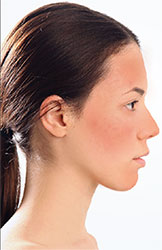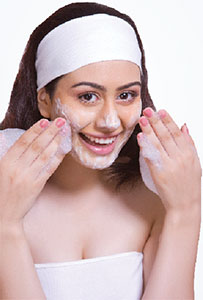Despite its prevalence, rosacea is often mistaken for rosy cheeks, sunburn, or acne, based on its classic appearance. This disorder is considered relapsing due to its come and go nature – a person will have painful-looking facial inflammation followed by calm periods where their skin appears clearer. During periods where a flare up is not present, the skin may remain red (persistent erythema). This disorder is divided into four main subtypes based of the clinical appearance of the symptoms: erythematotelangiectatic, papulopustular, phymatous, and ocular rosacea.
THE MAIN SUBTYPES
Erythematotelangiectatic Rosacea: Characterized by a plethora of features. There is persistent facial redness on the nose and cheeks, flushing associated with sweating or triggers, telangiectasias (visible, enlarged blood vessels in the skin), rough and scaly skin, and sensitive skin (intense burning, itching, stinging sensation when certain skin care products are used).  Papulopustular Rosacea: Characterized by papules (red pimples) and pustules (pus-filled pimples) in the presence of flushing on the central face. These pimples resemble typical acne. Rosacea differentiates from acne because there are no comedones (black heads) present in rosacea.
Papulopustular Rosacea: Characterized by papules (red pimples) and pustules (pus-filled pimples) in the presence of flushing on the central face. These pimples resemble typical acne. Rosacea differentiates from acne because there are no comedones (black heads) present in rosacea.
Phymatous Rosacea: Characterized by thickened skin caused by an overgrowth of tissue. The majority of affected clients are men.
Ocular Rosacea: Characterized by mostly eye symptoms such as redness (conjunctivitis), a sty, dry eyes, gritty eyelids, burning, development of cysts, blurry vision or loss of vision, sensitivity to light, and a pervasive feeling that something is stuck in the eye. This form of rosacea occurs independently or in association with the other subtypes.
The root cause of rosacea is thought to stem from a dysfunction in the immune system and stimulation of the body’s inflammatory system. Certain triggers stimulate the release of peptides that cause broken capillaries (blood vessels), leading to a flare up of rosacea, with symptoms of facial flushing and the aforemen-tioned symptoms.
 MANAGING ROSACEA
MANAGING ROSACEA
Since rosacea is a chronic condition that gets progressively worse, it is important to seek treatment from a physician, as early treatment can stop this disorder from worsening. Individuals experiencing signs and symptoms of rosacea are typically diagnosed based on clinical assessment, including examination of the skin and getting a detailed history from the client. There are many things a person can do to minimize symptoms of rosacea and help with overall management.
The first step in managing rosacea is maintaining a skin diary. It is important to keep a detailed log of triggers associated with episodes of flushing because this can aid in a plan for the management of the disorder, as well as associated symptoms. Keep in mind that symptoms of rosacea are easier to treat in the earlier stages of the disorder; therefore, seeking medical advice early is critical.
Now that a diary is put into place, clients should begin with lifestyle modifications, regardless of the rosacea subtype. Being able to identify triggers associated with flushing is an essential step in lifestyle modification. First, clients must remove and avoid all triggers associated with exacerbation of symptoms. The most common things to avoid are sun exposure, stress, hot baths, and certain foods. These behavioral changes will help prevent episodes of flushing associated with triggers, as well as prevent worsening of symptoms. Once clients begin management with lifestyle modifications, they typically notice a reduction in rosacea flare-ups. I recommend the following lifestyle changes:
- Clients need to apply a daily sunscreen with a sun protection factor (SPF) of 30, or higher.
- Clients should reduce stress by taking up yoga, meditation, or other stress-relieving activities.
- Clients must maintain a healthy food diet. The intake of certain foods rich in omega 3 fatty acids, minerals, and vitamins may aid in nurturing the skin.
- When using hairspray, clients need to make sure it does not get on their face.
In addition to lifestyle modifications, a thorough but gentle skin care regimen must be employed. This regimen should include four steps: gentle cleansing or double cleansing, serum or topical prescription medication, moisturizing, and concealing of more noticeable areas, if necessary. When rosacea flare-ups occur, it is important to use appropriate skin care products and minimize the amount of products being used overall. Clients with rosacea, particularly those with the erythematotelangiectatic subtype, may experience an increased level of sensitivity on their face. This, in turn, causes difficulty tolerating topical cosmetics, various skin care products, and topical medications. Because of the sensitive presentation of this disorder, it is important to treat rosacea effectively and gently. A proper skin care regimen for rosacea begins with cleansing the face and neck with a gentle cleanser. For optimal cleansing, clients should employ use of a gentle synthetic detergent cleanser. Gentle cleansers formulated with aloe, green tea, or chamomile extract help soothe and calm the inflamed skin. In addition to aloe, green tea, or chamomile, clients should look for other active ingredients such as ceramides, glycopeptides, hyaluronic acids, and retinols that help strengthen the skin. Peptides directly reduce redness and inflammation associated with rosacea. Products whose key ingredients are alcohol-based should be avoided, as that puts the skin at risk for reactivity. A good way to optimize cleansing is by alternating between a gentle cleanser and medicated cleanser. Medicated cleansers contain two percent pyrithione zinc and sodium sulfacetamide, which aid in minimizing redness. Physical or mechanical exfoliators are not recommended in the management of rosacea as this may potentiate more damage to the skin and often leaves it severely reddened. After all, the goal of gently cleansing is to reduce visible redness. Even if a clients does not have rosacea, gentle cleansers are a staple product for their skin care regime. They glide on gently, cleanse hypersensitive skin, and effortlessly remove makeup and buildup.
CLEANSING
All skin tends to get more oily throughout the day and there are some individuals who experience excess oil. For clients who have buildup from excess sebum, makeup, bacteria, perspiration, or even dust, double cleansing is a good way to ensure a proper deep cleanse. The process of double cleansing involves the use of two cleansers optimized for removing different types of impurities. There are several cleansers developed for double cleansing, available in creams, gels, or milk. It may sound counterintuitive to double cleanse if you have sensitive skin, but the opposite is true. Through an efficient double cleanse, clients with rosacea’s sensitive skin will become less reactive to certain triggers.
 How to Double Cleanse
How to Double Cleanse
Clients need to understand the steps of double cleansing. While professionals feel the steps might be second nature, it is important to break the process down and explain the steps of double cleansing. There are two parts to double cleansing. First, apply an appropriate amount of cleanser to dry, clean hands. Next, dab onto the forehead, each cheek, nose, and chin. Then, gently massage the cleanser into the skin, using circular motions. The circular motion helps break away, withdraw, and dissolve any makeup and impurities that were once lodged in the skin. Lastly, rinse away with lukewarm (97 to 102 degrees Fahrenheit) water. Never use extremely hot water, as this tightens and dries out the skin. Never use very cold water as this closes the pores, trapping remaining residue inside.
Now that the first cleanse has been done, it is time for the next. This typically employs a different facial soap or wash, which foams; however, some soaps may be harsh on rosacea-ridden skin, so an anti-inflammatory foaming cleanser is recommended. Lather the cleanser with water and create a foamy bed in the hands. Next, massage this all over the face and neck in circular motions. Concentrate on oil-prone areas such as the forehead and sides of nose, breaking away impurities. Rinse carefully and thoroughly with lukewarm water. Never leave cleansing residue on the face, as this causes build up and breakouts. Finally, pat the face dry. Remember, when cleansing, facial massages should be gentle. Remember, rosacea-ridden skin is sensitive and pressing or rubbing too hard can irritate the skin, leading to more inflammation.
MOISTURIZING
Once the skin is cleansed, clients should follow up with the application of a light serum to problematic areas. If the client’s doctor has prescribed topical medication for their face, they should not use the serum, as ingredients in the serum may have cross-reactivity with the topical medication. Medical treatment for rosacea is determined on a case-by-case basis, since some clients have combination of subtypes and some do not. Prescribing medication such as oral or topical antibiotics, azelaic acid, or low-dose retinoid is typically reserved for the moderate to severe cases. The diagnosis of moderate to severe is based on clinical presentation and response to initial management efforts. For severe cases, laser therapy or IPL treatments may be required to achieve long term reduction in facial redness and the appearance of visible blood vessels. Also, clients with rosacea should not use toners or astringents because of the drying effect; however, if their skin is extremely oily, a gentle, non-alcoholic toner may be used.
Since dry, rough skin is associated with rosacea, it is important to moisturize and hydrate the skin with a non-irritating moisturizer with SPF 30 or higher. Alternatively, clients can use both a moisturizer and sunscreen. A sunscreen that contains silicones such as dimethicone can help protect the skin and minimize redness and irritation. This should be the final step in the skin care regimen. Key ingredients that are more likely to be tolerated in rosacea prone skin include but are not limited to:
- Dextran sulfate – minimizes the appearance of swelling
- Ruscus – supports microexfoliation without vigorous activity
- Titanium dioxide – provides broad spectrum protection against UVA and UVB rays
- Zinc oxide – provides broad spectrum protection against UVA and UVB rays
- Vitamin E – antioxidant that destroys free radicals
- Green tea – antioxidant that destroys free radicals
- Hyaluronic acid – non-oily hydrating properties
- Glycerin – helps retain moisture
Ingredients to avoid include alpha hydroxy acids, beta hydroxy acids, vitamin C, alcohol, witch hazel, eucalyptus oil, peppermint oil, clove oil, and salicylic acid. These ingredients can potentially aggravate roscea.
 CONCEALMENT
CONCEALMENT
While treating a client’s skin for rosacea, results may not occur right away, since it takes time to reduce the facial redness and inflammation. For this reason, the client may opt to hide or cover up any redness or imperfections with makeup. Green-tinted concealers (liquid or cream formula) are a staple product for neutralizing rosacea-ridden skin. Redness can also be covered up using cream or liquid foundation. Concealers and foundations cover a range of skin concerns, including, but not limited to, rosacea, acne, and hyperpigmentation. Always set concealers or foundations with setting/translucent powder. Mineral makeup is a good alternative for clients who prefer sheer coverage because of its simple and calming ingredients. Mineral or powdered foundation fortified with zinc oxide, titanium oxide, caffeine, and mushroom extract help calm the skin and minimize any areas of redness. Using makeup to cover up redness can help clients achieve a refined look and help with self esteem issues related to their skin condition.
Having rosacea flare-ups can have a significant psychological and social impact on a person’s life. Clients experiencing rosacea flare-ups become embarrassed by their appearance and some avoid social and public interaction because of this. If a client’s rosacea symptoms are affecting their mood, and ultimately their way of life, they should contact their family doctor to be evaluated for depression. Never ignore signs of depression or anxiety, as early intervention is critical.
Therapy for rosacea is not curative. Therefore, symptom reduction is the best way to gauge progression (or lack thereof) of the disorder. Once a management plan is being executed, clients should monitor the number and duration of flare-ups and the appearance of papules and pustules. Employing a skin diary, avoiding triggers, practicing proper cleansing technique, and using a sunscreen, serum, topical medication (if needed) and a good moisturizer will help with managing and further reducing rosacea flare-ups. Treat ocular rosacea with artificial tears. Although there are many products that claim to reduce redness, seek advice from a professional, as early intervention is the key to successful treatment. A proper skin care regimen needs to be developed with a professional. While some clients may have life-long flare-ups of rosacea, treatment will prevent it from worsening. Once clients have a plan, it is important to remain consistent with their regimen. Remember, consistency breeds results!
 Dr. Gina Charles is the founder of Dr. G Makeup Artist, a makeup and skin care company, aimed at enhancing natural beauty and providing non-invasive treatments for various skin conditions. Charles provides a variety of services, including treatment of acne, hyperpigmentation, and bridal makeup. Charles is a family medicine physician, makeup artist, skin care professional, and global philanthropist. Between medically treating people and spear-heading Dr. G Makeup Artist, she volunteers her makeup services for breast cancer survivors, and mentors young women in career development. By combining her love for medicine and beauty, Charles proudly serves women of all ages.
Dr. Gina Charles is the founder of Dr. G Makeup Artist, a makeup and skin care company, aimed at enhancing natural beauty and providing non-invasive treatments for various skin conditions. Charles provides a variety of services, including treatment of acne, hyperpigmentation, and bridal makeup. Charles is a family medicine physician, makeup artist, skin care professional, and global philanthropist. Between medically treating people and spear-heading Dr. G Makeup Artist, she volunteers her makeup services for breast cancer survivors, and mentors young women in career development. By combining her love for medicine and beauty, Charles proudly serves women of all ages.
